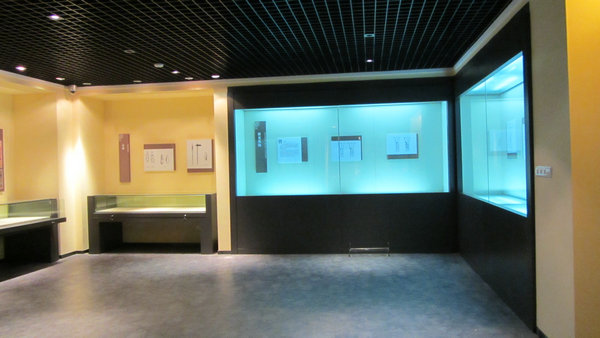
博物馆通柜也叫沿墙柜,比较高大,沿墙而建(2.5到3米,从地面一直伸到天花)。 柜子内空一般2米以上。常见的商业各类商业橱窗类似。
Museum cabinets are also called wall cabinets. They are tall and built along walls (2.5 to 3 meters, extending from the ground to smallpox). The inside of the cabinet is generally more than 2 meters. Common commercial commercial windows are similar.
安装在顶盖的照明器件,与展品之间的距离与天花差不多。所以选配灯具时,6-9W的LED灯足够了。
The distance between the illuminator installed on the top cover and the exhibits is almost the same as that of smallpox. So when the luminaire is selected, the 6-9W's LED lamp is sufficient.
通柜照明有两个特点,一是柜子的墙面会挂平面展品,如图画、丝织等;另外底座有摆件,需要重点照明。有的展品直接在底座上,有的会配摆架,看起来错落 。
There are two characteristics of the cabinet lighting. One is that the walls of the cabinet will be hung with flat objects, such as pictures and silk weaving. Besides, there are ornaments on the base, which need lighting. Some exhibits are directly on the pedestal, some will be equipped with pendulum frames, and appear to be scattered.
考虑展柜照明主要是墙面与底座。墙面是洗墙照明,底座是重点照明,这些对于非展柜照明是很容易处理的。但是展柜有些特殊性,因为它的空间小,展柜内宽一般0.8到1米,这么窄的空间里,要完成两种照明方式的布置,是比较难的。
Considering the main lighting of the display cabinet is the wall and the base. The wall is for wall lighting, and the base is the key lighting. These are easy to handle for non showcase lighting. But the showcase has some particularity, because its space is small, the width of the cabinet is 0.8 to 1 meters wide. In such a narrow space, it is difficult to complete the arrangement of two lighting methods.
早期的解决办法就是在柜顶做面光,配上雾玻璃或者压克力,把整个展柜打得很亮。由于太亮,显得没层次,和在阳光下没有两样。有些顶部光过亮了,会产生眩光。此照明处理,功能是满足了,但效果不好。我们应该考虑两全之策。
The early solution was to make the face light on the top of the cabinet, with fog glass or acrylic to make the display cabinet bright. Because it is too bright, there is no hierarchy, and there are not two in the sun. Some of the top light is too bright and will produce glare. This lighting processing function is satisfied, but the effect is not good. We should consider the policy of the two complete.
首先解决墙面照明,我们首选洗墙。采用专业灯具进行大面积均匀照射。墙面处理好了,我们再来考虑底部展品的重点照明。 墙面照明做好以后,会在底座产生一些基础照度,这是由于材料反射和灯具的余光造成,我们选择专业灯具将展品打亮就可以了。需要考虑的问题是投光的精准性可调性。因为底座的宽度有的大有的小,光从顶上下来,直径不能太大,否则有杂光或者眩光,需要处理掉。 我们通常选择变焦灯具,根据展品大小灵活调节光束角。对于比较简单的展品,直接打光下来就行了。对于相对复杂的展品,应考虑多角度侧打光, 否则阴影重。
First to solve the wall lighting, we preferred to wash the wall. Large area and uniform irradiation with professional lamps and lanterns. The wall is well handled. Let's consider the lighting of the bottom exhibits. After the wall lighting is done well, some basic illumination will be produced in the base, which is caused by the reflection of material and the residual light of the lamps and lanterns. The problem to be considered is the accuracy and adjustability of light projection. Because the width of the base is large or small, and the light can not come down from the top, the diameter should not be too large, otherwise there will be stray light or glare, which needs to be disposed of. We usually choose zoom lamps and flexibly adjust the beam angle according to the size of the exhibits. For a simpler exhibit, just finish it up. For relatively complex exhibits, multi angle side lighting should be considered, otherwise the shadow will be heavy.
这些处理好了,最后就要考虑眩光,眩光解决有两种办法:一种从安装方式上想办法。在侧板内侧,投光方向与视线一致是很好的办法。 另一种办法是在灯具上加防眩配件,有一些复杂展品,需要采用多种投光方式,不可避免会产生杂散光或者眩光,通过防眩配件将它们过滤掉就行了。
Finally, we need to consider the glare. There are two ways to solve glare: one is to think about the way of installation. Inside the side panel, the direction of light projection is in line with the line of sight. The other way is to add anti glare accessories on the lamps and lanterns. There are some complex exhibits. It is necessary to use a variety of lighting methods. It is unavoidable to produce stray light or glare. It can be filtered through the anti glare accessories.
这三方面处理好了,通柜照明基本满足了功能要求。但要做更好,还得与设计师商量,了解清楚展品需要表现的特质,营造的光氛围等。这是一个细致而繁琐的工作!
These three aspects are well handled, and the lighting of the cabinet basically meets the functional requirements. But to do better, we have to consult with the designers to understand the characteristics of the exhibits, and create a light atmosphere. This is a meticulous and tedious work!





